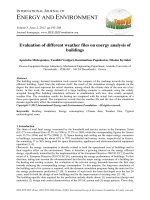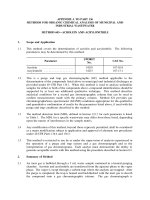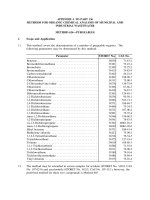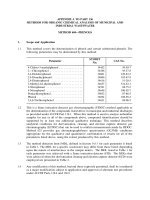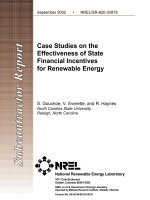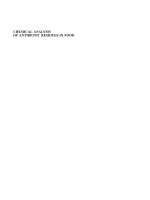Studies on chemical analysis of goat milk Basundi with red pumpkin pulp
Bạn đang xem bản rút gọn của tài liệu. Xem và tải ngay bản đầy đủ của tài liệu tại đây (244.49 KB, 6 trang )
Int.J.Curr.Microbiol.App.Sci (2019) 8(9): 2847- 2852
International Journal of Current Microbiology and Applied Sciences
ISSN: 2319-7706 Volume 8 Number 09 (2019)
Journal homepage:
Original Research Article
/>
Studies on Chemical Analysis of Goat Milk Basundi
with Red Pumpkin Pulp
Wakde Parmeshwar*, Shinde Anant and More Ramprasad
Department of AHDS, College of Agriculture,VNMKV, Parbhani- 431402, M.S., India
Dept of AHDS, College of Agriculture,Latur, India
*Corresponding author
ABSTRACT
Keywords
Basundi, red
pumpkin, chemical,
goat milk
Article Info
Accepted:
24 August 2019
Available Online:
10 September 2019
In the present study basundi was prepared with Red Pumpkin Pulp. The
different levels of red pumpkin pulp 2.5, 5 and 7.5 per cent were tried in
goat milk basundi. The requisite samples of basundi with different
treatments were subjected for proximate analysis viz. fat, protein,
Carbohydrate, moisture, total solid, sucrose and ash. The results obtained
were statistically analyzed by using completely randomized design. It was
observed that addition of red pumpkin pulp in goat milk basundi decreased
(moisture 48.82 to 46.64 per cent, fat 10.64 to 9.80 per cent sucrose 16.89
to 16.20 per cent) and increased (protein 8.15 to 8.64 per cent, ash 1.85 to
2.70 per cent, carbohydrate 30.89 to 32.29 per cent and total solid 51.18 to
53.37 per cent) content significantly in treated product(T1,T2 and T3) as
compared to control (T0).
Introduction
Goats are important component of livestock
industries and play vital role in the social
economic structure of economically weak,
rural community Goat milk differs from cow
or buffalo milk is having better digestibility,
alkalinity, buffering capacity and certain
therapeutic values in medicines and human
nutrition (Haenlein 2004).Due to significant
nutritional advantages of goat's milk, it is
widely used to feed more starving and
malnourished people in the developing world
than cow's milk. There is mounting evidence
from consumer observations that suggests
those who cannot tolerate cow’s milk can
tolerate goat’s milk. An important four year
survey of milk drinkers revealed that 66.8% of
those consuming goat’s milk did so for
medical reasons in particular to overcome
intolerance to cow’s milk and 27.71% of those
who consumed goat’s milk stated that they
received significant health benefits from the
product(Morgan
2012).
The
superior
digestibility of goat milk, the proper
composition of fatty acids and its content of
bioactive compounds seem to give properties
suitable for treating or preventing certain
2847
Int.J.Curr.Microbiol.App.Sci (2019) 8(9): 2847- 2852
medical conditions. Goat milk also has higher
proportions of polyunsaturated fat acid as well
as conjugated linoleic acid. Short and medium
chain fatty acids, as well as medium chain
triacylglycerols have become established
medical treatments for several clinical
disorders. Goat milk is rich in medium chain
triglycerides, which is one of the primary
reasons that it facilitates improved nutrient
absorption and energy production in the body.
(Roy and Vadodaria 2006).
Basundi is traditional, concentrated and
sweetened whole milk product having
sweetish caramal and pleasant aroma, light to
medium brown colour, thick body and creamy
consistency with or without soft textured
flakes that are uniformly suspended
throughout the product. It contains all the
solids of milk in an appropriate concentration
plus additional sugar and a dry fruit is
consumed directly as a delicious sweet
dish(Pagote, 2003).
Among the different vegetables red pumpkin
(Cucurbita moschata) belongs to family
Cucurbitaceae is one of the best-known
sources of beta- carotene, a powerful
antioxidant that gives orange vegetables and
fruits their vibrant colour. Red pumpkin is rich
sources of vitamins-A, C, E and K.
Treatment combinations
Following treatment combinations were
considered for preparation of basundi with red
pumpkin pulp.
T0= Basundi from goat milk (control)
T1= Basundi with 2.5 per cent of red pumpkin
pulp by weight of goat milk
T2= Basundi with 5.0 per cent of red pumpkin
pulp by weight of goat milk
T3= Basundi with 7.5 per cent of red pumpkin
pulp by weight of goat milk
Physico-chemical analysis of Shrikhand
Determination of moisture, total solids, ash,
sucrose
Determined by method as described in IS: SP
(part XI) 1981.
Determination of fat
Determined by Gerber´s method as in IS: 1224
(Part II) (1977).
Determination of protein
It is excellent sources of many polyphenolic
flavonoid compounds such as alpha, betacarotenes,
cryptoxanthin,
lutein
and
zeaxanthin, carotenes converted into vitamin
A inside the human body.
Protein content of basundi was determined
byMicrokjeldhal method as described in BIS
(1981).
Biologist suggests pumpkins to be highly
useful for treating hormonal disorders or
adolescent behavior, menopause disorder and
intestinal parasite. Hence considering the
benefits of fiber in the diet, with respect to its
nutritional and medicinal value present study
was proposed on “Studies on Preparation of
Goat Milk Basundi with Red Pumpkin Pulp.”
Carbohydrate content
subtraction method
Determination of Carbohydrate
was
estimated by
Statistical analysis
The data were analyzed statistically by using
Completely Randomized Design (CRD) as per
Panse and Sukhatme (1985).
2848
Int.J.Curr.Microbiol.App.Sci (2019) 8(9): 2847- 2852
Results and Discussion
Mean chemical composition of basundi with
different levels of red pumpkin pulp
The mean chemical composition for control
basundi (T0) and basundi with 2.5, 5 and 7.5
per cent red pumpkin pulp (T0, T1, T2 and T3)
are presented in table 1.
Moisture content of basundi
Moisture content of T0 (48.82) was
significantly higher than the T1, T2 and
T3.Among the treatments (T1, T2 and T3) per
cent moisture decreased significantly as the
level of red pumpkin pulp increased from 2.5
to 7.5 per cent. Significant decrease in
moisture content in basundi with red pumpkin
pulp could be due to the lower moisture
content in red pumpkin pulp (53 gm/100gm).
The result was in agreement with Raut
et.al(2018)and Lahankaret al., (2018).
Fat content of basundi
addition of red pumpkin pulp and treatment T3
had highest protein (8.64 per cent) content.
Among the treatments T3 had significantly
higher protein content than T2 and T1. This
may be due to protein content in red pumpkin
pulp (3gm/100gm). Similar findings were also
observed by Kolhe (2003), Matkar (2006).
Ash content of basundi
The mean ash content in the finished product
was 1.85,2.08,2.38,2.70 per cent for T0, T1, T2
and T3 respectively. From the result it was
observed that the ash content of control
(T0)(1.85 per cent) was significantly lower
than the T2 and T3.
Among the treatments (T1, T2 and T3) ash
content increased as the level of red pumpkin
pulp increased from 2.5 to 7.5 per cent Higher
ash content in basundi with red pumpkin pulp
could be due to mineral content in red
pumpkin pulp (15gm/100gm).The result is in
agreement with Waghmare (2012), Gaikwad
et al., (2016) and Kapare (2017).
From the result it was observed that the fat
content significantly decreased due to addition
of different levels (2.5, 5 and 7.5 per cent) of
red pumpkin pulp in basundi. Fat content of
control was (10.64per cent) highest among all
treatments. Significant decrease in fat content
in basundi with red pumpkin pulp could be
due to less fat content in red pumpkin pulp
(2.3 gm/100gm).The results are in agreement
with Bhutkaret al., (2015), Gaikwad et al., and
Hajareet al., (2016).
Carbohydrate content of basundi
Protein content of basundi
Significant increase in carbohydrate content of
basundi at higher level of addition of red
pumpkin pulp could be due to carbohydrate
content
in
red
pumpkin
pulp
(66.6gm/100gm).The result is in agreement
with previous research workers, Bankar
(2011), Navale et al., (2014).
Protein content of control basundi (T0) and
basundi with red pumpkin pulp (T1, T2 and T3)
was 8.15,8.31,8.46,8.64 per cent respectively.
The result showed that protein content of
control basundi (T0) was significantly lower
than the basundi with 2.5, 5 and 7.5 per cent
It was observed that the carbohydrate content
was increased significantly due to addition of
different levels (2.5, 5 and 7.5 per cent) of red
pumpkin pulp in basundi.
However, the carbohydrate content of T3
(32.29 per cent) was significantly higher than
the control (T0) as well as treatment T1.
2849
Int.J.Curr.Microbiol.App.Sci (2019) 8(9): 2847- 2852
Experimental Methodology
Fig.1 Flow diagram for preparation of Basundi with Red Pumpkin Pulp.
Basundi was prepared as per the method of Mukhekar, (2014).
Receiving of goat milk
↓
Filtration
↓
Standardization of milk (4% fat)
↓
Heating at simmering temperature (80-900 C)
↓
Stirring-cum-scrapping
↓
Addition of sugar (@ 5% of milk) and Red pumpkin pulp as per treatment
↓
Gentle heating till complete sugar dissolved and uniform mixing of Red Pumpkin Pulp
↓
Cooling at room temperature and addition of cardamom (1/2 tbsp)
↓
Packaging and storage of basundi at refrigeration temperature
Table.1Mean chemical composition of basundi with different levels of redpumpkinpulp
Sr.
No.
1
2
3
4
Chemical
constituents
Moisture (%)
Fat (%)
Protein (%)
Ash (%)
T0
T1
T2
T3
48.82a
10.64a
8.15c
1.85d
47.94b
10.30b
8.31bc
2.08c
47.17c
10.00c
8.46b
2.38b
46.64cd
9.80d
8.64a
2.70a
5
6
Carbohydrate(%)
Total solids (%)
30.89d
51.18d
31.78c
52.06c
31.99b
52.83b
32.29a
53.37a
7
Sucrose (%)
16.89a
16.53b
16.31bc
16.20cd
2850
Int.J.Curr.Microbiol.App.Sci (2019) 8(9): 2847- 2852
Total solids content of basundi
References
Total solid content of control basundi (T0) was
significantly lower (51.18) than the basundi
with red pumpkin pulp T1, T2 and T3 (52.06,
52.83, 52.37 per cent respectively).Moisture
content directly influenced the total solid
percentage; decrease in moisture content of
product increases the total solid content. The
highest total solid content was recorded in
treatment T3 (53.37 per cent) and lowest total
solid content was recorded for treatment T0
(51.18 per cent). However, among the
treatments total solid content increased
significantly as per cent level of red pumpkin
pulp increase from 2.5 to 7.5 per cent.
Increase in total solid content in treated
product could be due to lower moisture
content in red pumpkin pulp. The results are in
agreement with Pawar (2011).
Bankar, S.N. 2011. Studies on Preparation of
Pineapple Burfi. M.Sc.(Agri.) Thesis
submitted to MKV, Parbhani.
Bhutkar, S S., Patil, D.L., and Rupanawar,
D.A. 2015. Studies on Preparation of
Pedha Blended with Red Pumpkin.
IOSR. J. of Agriculture and Veterinary
ScienceVolume 8, Issue 3 Ver. I (Mar.
2015), PP : 01-03.
Haenlein, G.F.W.2004. Goat milk in human
nutrition. Small Ruminant Research,
51: 155-163.
Gaikwad, A.S., Chavan, K.D., and More, K.D.
2016. Preparation of Fibre Fortified
Basundi Using Date Fruit (Phoenix
dactylifera) J. ofNutrition and Health
Sciences Volume 3 ISSN: 2393 – 9060.
Hajare, V.H. 2011. Studies on preparation of
Almond Burfi.M.Sc. (Agri.) Thesis
Submitted to MKV, Parbhani.
IS: SP: 18 Part XI. 1981. Methods of test for
dairy industry. Rapid examination of
milk. Indian Standard Institution,
Manak Bhavan, New Delhi.
ISI 1977. IS: 1224 (Part II) Determination of
Fat by Gerber’s Method. Indian
Standard Institution, Manak Bhavan,
New Delhi.
Kapare, P.B. 2017. Studies on Preparation of
Burfi Blended with Finger Millet. M.
Sc (Agri) Thesis Submitted to
VNMKV Parbhani.
Kolhe, P.Y. 2003. Utilization of Papaya Pulp
in Preparation of Burfi. M.Sc. (Agri.)
Thesis submitted to Dr. PDKV, Akola.
(MS).
Lahankar, S.V., Narwade, S.G., and Kamble,
N.S. 2018. Preparation of Burfi
Blended with Green Peas.Int. J. Curr.
Microbiol. App. Sci (2018) Special
Issue-6: 2320-2325
Matkar, S.P. 2006. Preparation of Fig Burfi.
M.Sc. (Agri.) Thesis submitted to
MKV, Parbhani
Sucrose content of basundi
It was observed that the sucrose content in
control (T0) and treatment T1, T2 and T3 was
16.89,16.53,16.31,16.20 per cent respectively.
Among the treatment’s sucrose content of
T0(16.89) was highest where as T3 (16.20).
From present investigation it can be concluded
that the red pumpkin can be very well utilized
for preparation of palatable, nutritional
basundi. From the results of chemical analysis
of goat milk basundi with addition of red
pumpkin pulp (2.5, 5 and 7.5 per cent) it could
be concluded that red pumpkin pulp could be
incorporated up to 7.5 per cent in basundi
without affecting sensory properties adversely.
Addition of red pumpkin pulp in
basundidecreased moisture, fat, and sucrose
content significantly in the finished product as
compare to control. Protein, ash, carbohydrate
and total solid content was increased
significantly in treated product as compared to
control.
2851
Int.J.Curr.Microbiol.App.Sci (2019) 8(9): 2847- 2852
Morgan D, Gunneberg C, Gunnell D, Healing
TD,
Lamerton
S.2012.Medicinal
properties of goat milk. J Dairy Goat
90: 1.
Mukhekar, A.S. 2014. Preparation of Basundi
Blended with Mango Pulp cv. Kesar.
M.Sc (Agri.) Thesis, Submitted to
VNMKV, Parbhani.
Navale, A.S., Deshmukh, B.R., Narwade,
S.G., Korake, R.L., and Mule, P.R.
2014. Production profile proximate
composition, sensory Evalution and
Cost Configuration of Wood Apple
Burfi. Animal Science Reporter. 8 (3):
114 - 120
Pagote, C.N. 2003. Basundi: A Traditional
Delicious Milk Product. Beverage and
Food World, 30(6): 29.
Panse, V.G., and Sukhatme, P.V. 1985.
Statistical Methods for Agricultural
Workers. ICAR
Publication, New Delhi.
Pawar, S.B. 2011. Studies on preparation of
burfi blended with dried date. M.Sc.
(Agri) Thesis submitted to MKV,
Parbhani.
Raut, M. M. 2018. Studies on preparation of
buffalo milk basundi with red pumpkin
pulp. M.Sc.(Agri.) Thesis submitted to
VNMKV, Parbhani.
Roy, S.K, and Vadodaria, V.P. 2006. Goat
Milk and Its Importance. Indian
Dairyman 58: 65-9.
Waghmare, V.K. 2012. studies on preparation
of bottle gourd burfi. M.Sc. (Agri.)
Thesis Submitted to MKV, Parbhani
(MS).
How to cite this article:
Wakde Parmeshwar, Shinde Anant and More Ramprasad 2019. Studies on Chemical Analysis
of Goat Milk Basundi with Red Pumpkin Pulp. Int.J.Curr.Microbiol.App.Sci. 8(09): 28472852.doi: />
2852

